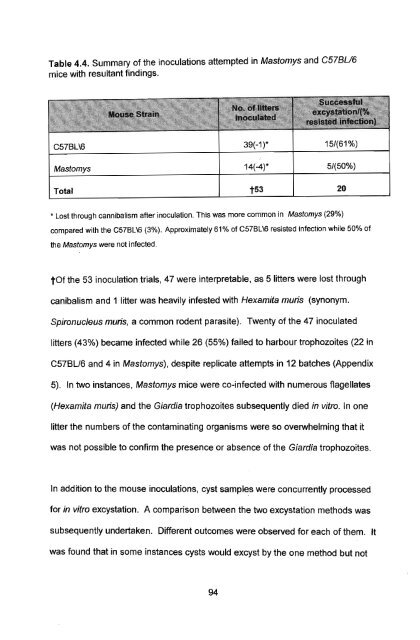in vitro culture and isoenzyme analysis of giardia lamblia
in vitro culture and isoenzyme analysis of giardia lamblia
in vitro culture and isoenzyme analysis of giardia lamblia
Create successful ePaper yourself
Turn your PDF publications into a flip-book with our unique Google optimized e-Paper software.
Table 4.4. Summary <strong>of</strong> the <strong>in</strong>oculations attempted <strong>in</strong> Mastomys <strong>and</strong> C57BU6<br />
mice with resultant f<strong>in</strong>d<strong>in</strong>gs.<br />
C57BL\6 39(-1)* 15/(61%)<br />
Mastomys 14(-4)* 5/(50%)<br />
Total t53 20<br />
* Lost through cannibalism after <strong>in</strong>oculation. This was more common <strong>in</strong> Mastomys (29%)<br />
compared with the C57BL\6 (3%). Approximately 61% <strong>of</strong> C57BL\6 resisted <strong>in</strong>fection while 50% <strong>of</strong><br />
the Mastomys were not <strong>in</strong>fected.<br />
tOf the 53 <strong>in</strong>oculation trials, 47 were <strong>in</strong>terpretable, as 5 litters were lost through<br />
canibalism <strong>and</strong> 1 litter was heavily <strong>in</strong>fested with Hexamita muris (synonym.<br />
Spironuc/eus muris, a common rodent parasite). Twenty <strong>of</strong> the 47 <strong>in</strong>oculated<br />
litters (43%) became <strong>in</strong>fected while 26 (55%) failed to harbour trophozoites (22 <strong>in</strong><br />
C57BU6 <strong>and</strong> 4 <strong>in</strong> Mastomys), despite replicate attempts <strong>in</strong> 12 batches (Appendix<br />
5). In two <strong>in</strong>stances, Mastomys mice were co-<strong>in</strong>fected with numerous flagellates<br />
(Hexamita muris) <strong>and</strong> the Giardia trophozoites subsequently died <strong>in</strong> <strong>vitro</strong>. In one<br />
litter the numbers <strong>of</strong> the contam<strong>in</strong>at<strong>in</strong>g organisms were so overwhelm<strong>in</strong>g that it<br />
was not possible to confirm the presence or absence <strong>of</strong> the Giardia trophozoites.<br />
In addition to the mouse <strong>in</strong>oculations, cyst samples were concurrently processed<br />
for <strong>in</strong> <strong>vitro</strong> excystation. A comparison between the two excystation methods was<br />
subsequently undertaken. Different outcomes were observed for each <strong>of</strong> them. It<br />
was found that <strong>in</strong> some <strong>in</strong>stances cysts would excyst by the one method but not<br />
94
















